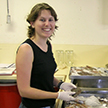Related Questions
- have you ever got hurt while looking at bacteira
- How does bacteria eat other bacteria? Does it like dissolve it?
- you know how there's photosynthesis? is there a name for that happening with sea grass and other marine plants?
- What made you choose marine biology instead of performance arts and psychology? they are all so different! These are









There are a heap of bacteria that wildlife need in the deep oceans to help them live there. in the Deep oceans there are places called cold seeps. Cold seep is the general name given to areas of the ocean where hydrogen sulfide, methane and other hydrocarbon-rich fluids are able to seep through the floor.
Cold seeps occur over cracks in the sea floor where there is tectonic activity (movement of the continents).
When a seep occurs the first animals that can live there are bacteria called extremophiles. These are species bacteria that can live in extreme conditions. These seeps are extreme because methane and hydrogen sulphide are not chemicals that can be used by animals or plants to produce energy to grow. but these extremophile bacteria can!!!
Then a mussel called Bathymodiolus starts to grow and they have a symbiotic relationship with the bacteria. This means that the bacteria live in the mussel and take the methane and turn it into energy (sugar). The mussel then uses the sugar to grow. After a while other marine animals can grow there too like the marine worms called siboglinid tubeworms. But these worms have a symbiotic relationship with a different bacteria that can turn Hydrogen sulphide in to energy.
So this is the same as plants on the land taking in carbon dioxide and light to make sugar. Then we eat the fruit or leaves to help us grow. The only difference is we always believed that life could only exist if there was sun light, because plants need this to photosynthesis. But know we know from these cold seeps that we don’t need light because some bacteria can use other chemicals to produce energy for animals it grow. This is called chemosynthesis.
1
We, as yet do not understand the microbial kingdom. But is clear that fr things to live thay need to derive energy. From light, photosynthetic. From chemical interactions, chemosynthetic. Last week some researchers found methane and sulphide cycling (chemosynthetic) bacteria 1.6 kilometres below the earths crust. So there may be life on Mars yet!
1
I think Simon and Shona have answered this amazingly well. I’ve learnt quite a bit from their answers myself, like about the bacteria 1.6kms below the Earth’s crust! How do scientists find such things? Amazing.
0